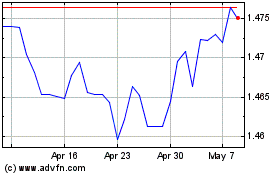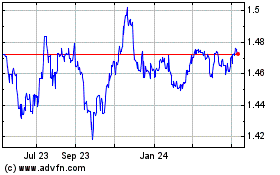Canadian Dollar Climbs As Oil Prices Rise On OPEC Hopes
November 30 2017 - 3:32AM
RTTF2
The Canadian dollar advanced against its major rivals in the
European deals on Thursday, as oil prices rose amid media reports
that OPEC is likely to extend its supply quota deal by nine months
through the end of 2018.
Crude for January delivery rose $0.45 to $57.75 per barrel.
Saudi Arabia oil minister Khalid al-Falih told reporters that he
opts for a nine-month extension of existing cuts and wants support
from other countries.
"Market stability has improved and the sentiment is generally
upbeat. The rebalancing trend has accelerated and inventories are
on a generally declining trend," he said.
Wednesday's U.S. inventories data showing a significant decline
in domestic inventories also propped up oil prices.
U.S. commercial crude oil inventories (excluding those in the
Strategic Petroleum Reserve) decreased by 3.4 million barrels from
the previous week.
This follows a decline of more than 6 million barrels the
previous week, and contrasts this week's report from the American
Petroleum Institute which showed a surprising build in
stockpiles.
Investors also awaited the U.S. Senate vote on major tax reform
bill due today or tomorrow. The chamber cleared a procedural vote
on Wednesday by a margin of 52-48 to begin formal debate on tax
legislation.
The currency traded mixed in the Asian session. While it fell
against the euro and the aussie, it rose against the yen. Against
the greenback, it held steady.
The loonie recovered to 1.2876 against the greenback, from an
early new 4-week low of 1.2902. If the loonie rises further, 1.27
is possibly seen as its next resistance level.
The loonie bounced off to 87.24 against the yen, from a low of
86.94 hit at 5:00 pm ET. This may be compared to a 3-day high of
87.29 hit at 4:15 am ET. Next key resistance for the loonie-yen
pair is seen around the 88.00 region.
Data from the Ministry of Land, Infrastructure, Transport and
Tourism showed that Japan's housing starts declined for the fourth
straight month in October, and at a faster-than-expected pace.
Housing starts fell 4.8 percent year-on-year in October, bigger
than September's 2.9 percent decrease. That was also above the 2.8
percent drop economists had forecast.
Following a 3-week low of 0.9765 hit at 12:45 am ET, the loonie
rose back to 0.9736 against the aussie. The loonie is seen finding
resistance around the 0.96 mark.
On the flip side, the loonie weakened to a 1-1/2-year low of
1.5288 against the euro, off its early high of 1.5224. On the
downside, 1.55 is possibly seen as its next support level.
Flash data from Eurostat showed that Eurozone inflation
increased in November largely due to higher energy prices.
Consumer prices advanced 1.5 percent year-on-year in November,
following October's 1.4 percent increase. Inflation was forecast to
rise to 1.6 percent.
Euro vs CAD (FX:EURCAD)
Forex Chart
From Mar 2024 to Apr 2024

Euro vs CAD (FX:EURCAD)
Forex Chart
From Apr 2023 to Apr 2024
